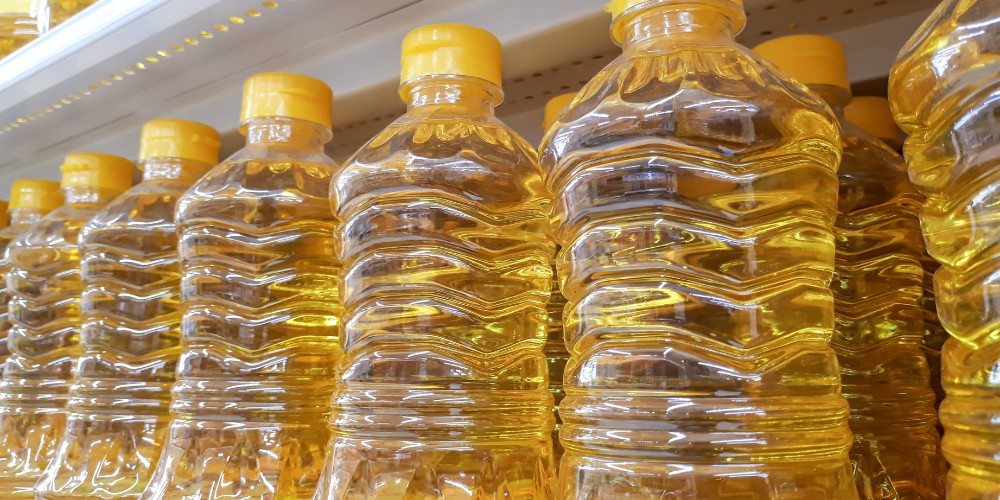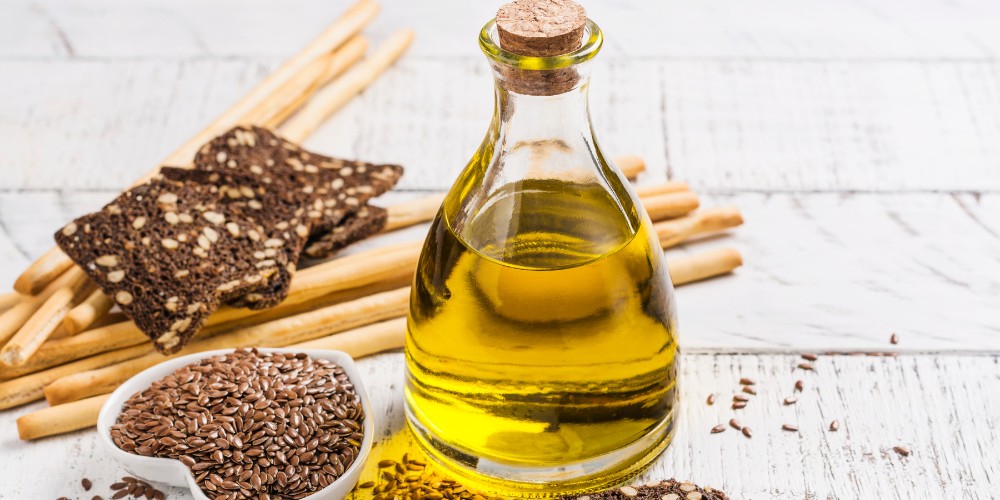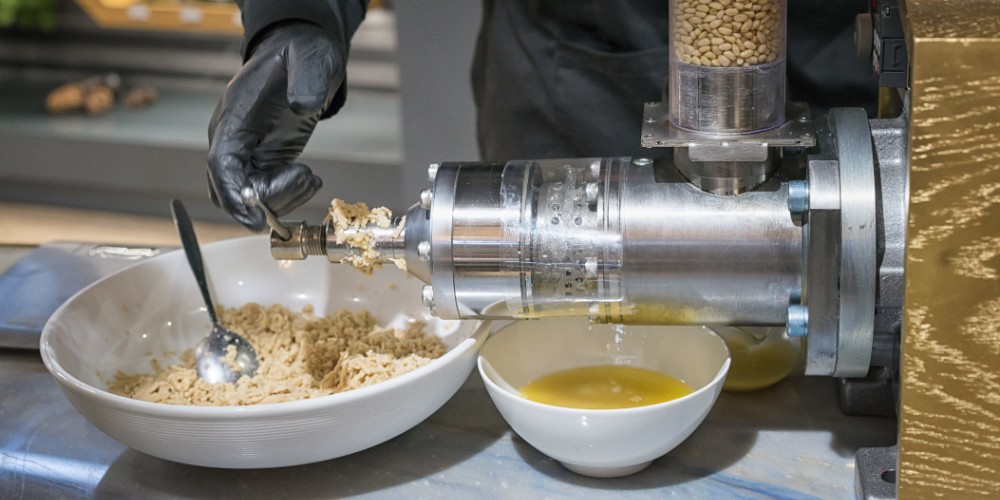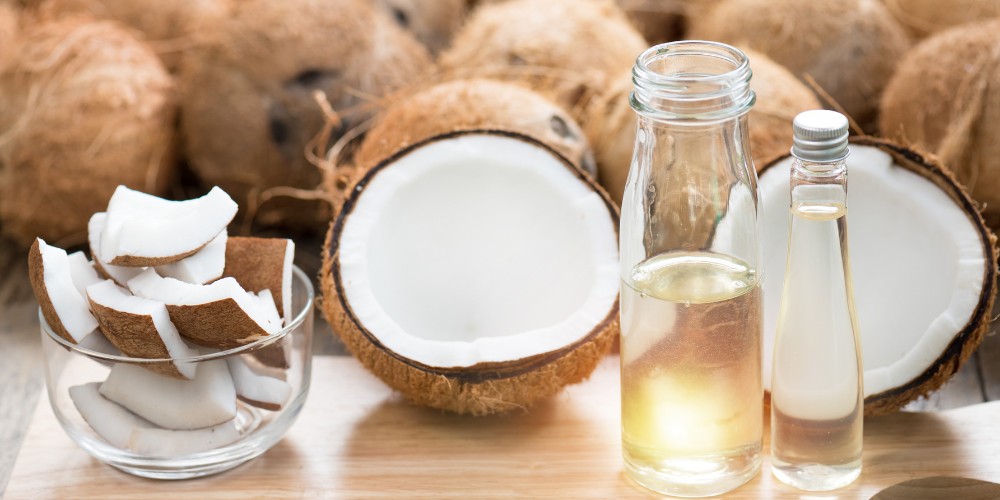Americans, on average, intake over 40 grams (approximately 3 tablespoons) of vegetable oil daily. These oils, like those from soy, corn, or canola, are abundant in linoleic acid (LA), an essential omega-6 fatty acid.
Essential omega-3 fatty acids can be sourced from oils like soy, canola, flaxseed, and certain cold-water fish such as tuna, salmon, and herring. There have been many controversial messages on the internet claiming that seed oils are harmful to you, but how accurate are these claims?
Despite the controversies and concerns surrounding seed oils, most research suggests a neutral or beneficial health impact. It’s crucial to consume them in moderation, like any other food. Fearing seed oils and labeling them “toxic” may be a far stretch when considering the existing data.
There is a lot of ground regarding seed oils and the misinformation surrounding them, so grab a cup of tea and buckle up as we dive into the science of seed oils.
Table of Contents
- What Are Seed Oils?
- Is Vegetable Oil A Seed Oil?
- Cold-Pressed vs. Processed Oils
- Debunking Seed Oil Myths
- Are Processed Oils More Unhealthy Than Cold-Pressed Oils?
- Should You Avoid Seed Oils?
- Your Guide To Fat Types
- How To Know Which Oil To Use? The Smoke Point Explained
- Best Seed Oils For Cooking
- Olive Oil (Regular Or Light)
- Summary
What Are Seed Oils?
Seed oils are oils that are extracted from the seeds of plants. These oils are commonly used for cooking, as well as for various industrial and cosmetic purposes. Different seeds yield oils with distinct flavors, nutritional profiles, and uses. Some common types of seed oils include [1, 2]:
- Sunflower Oil: Extracted from the seeds of sunflowers, it is a versatile oil with a mild flavor. It is often used in cooking and as a salad oil.
- Soybean Oil: Derived from soybeans, soybean oil is one of the most widely used cooking oils. It is also used to produce various food products and industrial applications.
- Canola Oil: Made from the seeds of the canola plant, a type of rapeseed, canola oil has a mild flavor and a high smoke point, making it suitable for various cooking methods.
- Corn Oil: Produced from the germ of corn, corn oil is commonly used in cooking, frying, and as an ingredient in many food products.
- Cottonseed Oil: Extracted from the seeds of cotton plants, cottonseed oil is used in cooking and producing salad dressings and margarine.
- Sesame Oil: Obtained from sesame seeds, sesame oil is commonly used in Asian cuisine for its distinctive nutty flavor. It comes in both light and dark varieties.
- Flaxseed Oil: Also known as linseed oil, it is derived from flaxseeds and is rich in omega-3 fatty acids. Due to its low smoke point, it is often used as a nutritional supplement rather than for cooking.
- Grapeseed Oil: Extracted from the seeds of grapes, grapeseed oil is a light and neutral-tasting oil with a high smoke point, making it suitable for various cooking methods.
- Pumpkin Seed Oil: Made from roasted pumpkin seeds, this oil has a rich, nutty flavor and is often used as a finishing oil for salads and other dishes.
- Chia Seed Oil: Chia seeds, known for their nutritional benefits, can be pressed to extract chia seed oil, which is rich in omega-3 fatty acids.
Is Vegetable Oil A Seed Oil?

The two terms are used interchangeably, but there is a slight difference. Vegetable oil is a broad term that can include various types of oils derived from plant sources, and many vegetable oils are, in fact, seed oils. Vegetable oils are extracted from different parts of plants, including seeds, fruits, nuts, and even some vegetables.
Seed oils only refer to the oils extracted from the seeds of their respective plants, for example, common vegetable oils like soybean oil, canola oil, sunflower oil, and cottonseed oil.
These oils are categorized as seed oils because they come from the seeds of plants rather than from fruits or other plant parts.
Cold-Pressed vs. Processed Oils
Cold-pressed and processed oils differ in extraction methods, and these distinctions can impact their nutritional profile, flavor, and overall quality.
Extraction Method
- Cold-Pressed Oils: These oils are extracted by mechanically pressing the oil from the seeds, nuts, or fruits without using heat. The process involves a hydraulic or expeller press, which helps retain the oil’s natural flavor, aroma, and nutritional value.
- Processed Oils: Processed oils typically undergo refining, which involves using heat, chemicals, or mechanical processes to extract the oil. This can include using solvents, bleaching, and deodorizing to achieve a clear, neutral-tasting final product.
Temperature
- Cold-Pressed Oils: The extraction process for cold-pressed oils occurs at temperatures below 50°C (122°F). This lower temperature helps preserve the oil’s original characteristics.
- Processed Oils: Processing often involves higher temperatures, which may affect the oil’s flavor and nutritional content. The use of heat can also contribute to the breakdown of some beneficial compounds.
Nutritional Content
- Cold-Pressed Oils: These oils may retain more of the natural antioxidants, vitamins, and minerals present in the original source. They often have a stronger flavor and a deeper color due to the presence of these natural compounds.
- Processed Oils: The refining process removes impurities. As a result, processed oils may have a milder flavor and a lighter color. In some cases, there might be a slight decrease in the antioxidant levels. However, if you look at the studies used in the literature, the antioxidant levels of oils were assessed on finished oils, and plant oils have still been found to be good sources of antioxidants like vitamin E [3].
Smoke Point
- Cold-Pressed Oils: Some cold-pressed oils may have lower smoke points than their processed counterparts. This means they may be more suitable for low to medium-heat cooking.
- Processed Oils: The refining process can raise the smoke point of oils, making them more suitable for high-heat cooking methods.
Stability and Shelf Life
- Cold-Pressed Oils: These oils may have a shorter shelf life and can be more prone to rancidity due to the presence of natural compounds.
- Processed Oils: The refining process can improve stability and extend shelf life by removing impurities and potential sources of oxidation.
Debunking Seed Oil Myths

Inflammation
Before we discuss the effect of seed oils on inflammation, it is important to understand what inflammation is. Inflammation is the body’s natural response to injury, infection, or irritation.
It is a complex biological process that involves the activation of the immune system to protect the body and promote healing [3].
While acute (short-term) inflammation is a normal and essential part of the body’s defense mechanism, chronic (long-term) inflammation can contribute to various diseases if it persists over an extended period. Oxidation in the body can trigger inflammation [4].
What is oxidation?
Oxidation in the context of inflammation refers to a process where molecules, such as lipids and proteins, undergo chemical reactions that place stress on the body. This oxidative stress is often a result of the immune system’s response to injury or infection.
While oxidative reactions play a role in combating pathogens like viruses and bacteria, excessive or prolonged oxidative stress can contribute to tissue damage and inflammation.
Balancing oxidative and antioxidant processes is crucial for maintaining overall health and regulating the inflammatory response.
Plenty of studies have found that seed oils reduce inflammation and can be beneficial in treating conditions that have inflammation as an underlying or root cause, for example:
- Grape seed oil, in insulin resistance and overweight/obesity [5]
- Pomegranate seed oil, sesame oil, acer truncatum bunge seed oil, hemp seeds oil, evening primrose seed oil, coconut oil, walnut oil, essential oil from Pterodon emarginatus seeds, flaxseed oil, and olive oil in multiple sclerosis [6]
- Pumpkin, melon, black cumin seed, and argan seed oil in patients with age-related diseases [7]
- Hemp seed and evening primrose oils in multiple sclerosis [8]
- Flaxseed oil in cardiovascular disease, hypertension, diabetes, dyslipidemia, inflammation [9]
- Canola oil in a variety of populations [10]
So why do some people say that seed oils lead to inflammation?
Despite consistent positive recommendations regarding dietary linoleic acid (LA) or omega-6 fats, there’s notable concern about its potential role in excess inflammation.
One often-used argument is that vegetable oils add too much omega-6 fats to the diet, which causes increased inflammation.
The complex literature in this area has resulted in differing conclusions among various narrative reviews, contributing to the confusion of many people [11, 12, 13, 14].
A systematic review was then done of 15 clinical trials, recently published, and it did not find evidence supporting the “dietary linoleic acid causes inflammation” hypothesis.
These results align with existing recommendations that a diet comprising 5 to 10% energy from polyunsaturated fatty acids, including linoleic acid, is beneficial and suitable for most people.
The authors also pointed out some flaws in the studies they looked at and concluded that the literature on the topic is fuzzy at best.
It is vital you eat enough omega 3 fats in your diet to ensure a good omega 6:3 balance [15], but remember vegetable oils are not all 100% omega 6.
Most oils combine both, and oils like walnut oil, flaxseed oil, and canola oil have more omega 3 than 6 – so even if it were true that omega 6 contributes to inflammation, it would not be reason enough to cut out all seed oils.
Another popular myth is that seed oils contribute to long-term inflammation by decreasing the “lag time” to oxidation.
What is “lag time”?
Imagine lag time in lipid oxidation as the calm before the storm. Lipids represent a serene body of water in this metaphor, and oxidation is the impending storm.
The lag time is tranquil when the weather is clear, and the water’s surface is undisturbed. The elements necessary for oxidation are present during this phase, but the process has yet to begin.
When the storm finally arrives, it symbolizes the initiation of lipid oxidation, bringing about changes and reactions in the once-peaceful lipid environment.
The lag time can be seen as the delay between the potential for oxidation and the actual onset of the oxidative process, akin to the delay before the storm disrupts the calm waters.
One way seed oils are thought to contribute to the risk of inflammation is by causing the oxidation of polyunsaturated fats (PUFA), especially linoleic acid, in the membranes of low-density lipoprotein (LDL), a complex of fats and proteins that transports cholesterol in the bloodstream.
LDL carries cholesterol from the liver to cells throughout the body. Still, when there is an excess, it can contribute to the buildup of plaque in the arteries, leading to atherosclerosis and other heart-related issues. Maintaining a healthy balance of LDL cholesterol is essential for cardiovascular health.
Heart Disease

Since the 1970s, researchers have been aware that linoleic acid (LA) helps lower blood cholesterol levels, reducing the risk of heart disease.
An American Heart Association (AHA) Science Advisory recently recommended that omega-6 PUFA constitute at least 5 to 10% of total energy [22].
Moreover, a recent Position Statement by the American Dietetic Association, now known as the Academy of Nutrition and Dietetics and Dietitians of Canada, has emphasized the suggested intake range for omega-6 polyunsaturated fatty acids (particularly linoleic acid) in the United States [23].
This recommendation is based on guidelines provided by the National Heart, Lung, and Blood Institute (NHLBI) of the National Institutes of Health (NIH) and the Institute of Medicine (IOM), advocating for an intake ranging from 5 to 10% of total energy consumption [24, 25].
Numerous studies have shown that consuming olive oil and omega-3 fats lowers the risk of heart disease [26].
One review compared olive oil, sunflower seed, fish, and palm oil. The authors concluded that the current literature shows that, despite controversy, these four oils have more beneficial than detrimental effects on heart health and, if eaten in moderation, can be part of a healthy diet.
Include various fats in your diet, including omega 6 and omega 3, to optimize the omega 3:omega 6 ratio. Still, removing oils containing omega 6 entirely from the diet is unnecessary, as they do have a role in the body.
Where does the idea that seed oils cause heart disease come from?
Two studies frequently cited to support the idea that seed oils increase cardiovascular disease risk are the Sydney Diet Heart Study (SDHS) conducted by Woodhill et al. (1978) and the Minnesota Coronary Experiment (MCE) by Frantz et al. (1989) [27, 28, 29].
Both trials were structured such that saturated fatty acids (SFA) were intended to be substituted with polyunsaturated fatty acids (PUFA) in the intervention groups through vegetable oil-based margarine, while PUFA was to be replaced with SFA in the control groups.
It’s important to highlight that the Sydney Diet Heart Study (SDHS) was a secondary prevention trial, meaning participants had already experienced a single cardiovascular disease (CVD) event before enrolment.
Considering the uncertain clinical significance of the ultimate differences in total cholesterol between groups, the meaningfulness of the findings becomes even more ambiguous.
In addition, it is often argued seed oils cause inflammation and, as a result, heart disease. As seen in the previous section, most research does not show that seed oils cause inflammation, so this argument has already been refuted.
DNA Damage

The idea that seed oils cause DNA damage first originates in the hypothesis that seed oils cause inflammation and, as a result, DNA damage. We discussed in detail why this is not the case in the previous section.
However, research shows that reheated oils – for example, oils used in fast-food restaurants to optimize revenue – can cause inflammation and risk DNA damage due to the by-products formulated in the cooking process [30, 31].
However, note that reheating oils differ from heating them the first time. You will have a very different health effect if you use the oil once versus if you use it, pour it out, and use it again to save money.
In contrast with the data on reheated oils, the research on seed oils mostly shows that they are protective for DNA, even though there is less research on the topic than on cardiovascular disease.
In one study, cooking oils with antioxidants were used to prepare breakfast items, and it was found that olive oil and olive oil/canola oil with antioxidants had a beneficial effect on DNA oxidation damage (whereas sunflower oil did not) [32].
Another study on young men found that corn oil and olive/sunflower oil were protective against DNA damage and that corn oil outperformed the olive/sunflower group despite having higher levels of omega 6 [33].
An in-vitro study (granted, it always needs to be done on humans) found that Koelreuteria paniculata seed oil showed DNA protective activity.
Similarly, in an in vitro study, grape seed oil was DNA-protective in cancer patients receiving chemotherapy.
Overall, no evidence shows that seed oil consumption leads to DNA damage, except when it is reused after cooking.
Cancer

Cancer is a complex group of diseases characterized by the uncontrolled growth and division of abnormal cells in the body.
These cells can invade surrounding tissues and spread to other body parts through the blood and lymph systems. Cancer can arise in almost any organ or tissue and may form a mass or lump of tissue called a tumor.
Where does the rumor that seed oils cause cancer come from?
The hypothesis is that, when subjected to heat, seed oils release substances that can cause cancer, like aldehydes. The harmful substances come from breaking the fatty acids in the oil.
Some of them can evaporate, but others stick around even after frying. The amount of these degraded products increases when food is heated and reheated.
As the oil is used again and again, the amount of harmful substances becomes carcinogenic or able to cause cancer [34, 35].
There are a few things to consider here. Firstly, the associations between cancer and oils are, as mentioned in the DNA section, found in oils that have been reused or reheated, often up to 3 times [36, 37, 38].
It’s important to realize there is a big difference between reheated oil and oil you use to cook your stir-fry for dinner.
Often, reheated oils also occur with other unhealthy foods, like fried foods and fast foods, and we already know that these foods, in high quantities, are not the best options.
This might also happen if oils are heated at an inappropriate smoke point, which will be discussed later in the article.
Many of the studies point to a protective effect for certain oils. When looking at intervention studies, one research study showed that the phytosterols and phytostanols in oils show anti-cancer properties [39].
Another study [40] on an Italian population found favorable effects of olive oil and other vegetable oils on ovarian cancer. In a study of 1953 hospital patients, mixed seed oils did not impact colorectal cancer risk, which did not differ by fat type [41].
Some rodent and in-vitro (lab-based) studies showed similar trends of seed oils showing anti-cancer properties (although I much prefer looking at human studies and always take animal studies with a pinch of salt).
Pomegranate seed oil, rich in conjugated linolenic acid, suppresses chemically induced colon cancer in rats [42]. In an in-vitro study, flaxseed oil enhanced anti-cancer activity [43].
According to the current body of evidence, there is not enough evidence to indicate that seed oils lead to cancer; if anything, most research studies point to the beneficial effects of seed oils on cancer.
Insulin Resistance

Insulin resistance is comparable to a lock-and-key mechanism losing its precision. Imagine insulin as a key trying to unlock cells (doors).
In resistance, the lock becomes less responsive, requiring more effort from the key. This inefficiency hinders glucose entry, akin to the struggle for access when the lock isn’t as receptive to the key.
The idea that seed oils lead to insulin resistance comes from the fact that insulin resistance and inflammation are closely correlated.
We have already refuted the inflammation hypothesis. Another argument is that free fatty acids in the blood can cause insulin resistance.
However, is there any science behind the idea that seed oils cause insulin resistance?
It’s easy to take the headings of studies and make conclusions based on what you see. But to know what the data means, you have to dive into the methods, dosages, and statistics and see if what is done in studies actually translates to humans.
One study [44] found “Soybean and sunflower oil-induced insulin resistance.” However, when looking at the methods in this study, you will see that it was a rat study where the plant oils were injected into the mice at relatively high dosages.
There is limited translatability between the methods in this study and the way that human bodies may react when eating plant oils.
Grape seed oil improved insulin resistance in overweight and obese women [45].
In a Chinese cohort, intakes of lard, peanut oil, and refined blended plant oil but not soybean oil, canola oil, and sesame oil are associated with higher type 2 diabetes risk.
The authors recommend increasing the intake of soybean oil in replacement of lard, peanut oil, and refined blended plant oil. However, in this study, peanut oil and refined plant oils were used for deep frying.
There are a few things when deep frying that can affect insulin resistance. Usually, deep-fried foods are also high in simple carbohydrates, and overconsumption of simple carbohydrates can lead to insulin resistance.
It is also easy to overconsume calories from deep-fried foods, leading to increased body fat and as a result, insulin resistance. Lastly, the possibility of reusing oil is there if foods are deep-fried.
So, not just the oils themselves but the practices surrounding deep-fried foods may influence the risk of diabetes.
Finally, the collective findings in existing literature indicate that medium-chain saturated fats, such as lauric acid present in coconut oil, and monounsaturated fats, like oleic acid found in olive oil, are less prone to contribute to insulin resistance, inflammation, and fat storage compared to long-chain saturated fatty acids.
This holds particularly true when these fats are consumed as part of a moderate diet of refined carbohydrates [46].
Chronic Disease
Many anti-seed oil fanatics argue that seed oils a) cause inflammation (which we have already discussed) and b) omega-6 oils cause impairments in mitochondrial function, the cell’s powerhouse.
However, the one narrative review [47] that alludes to the role of seed oils in mitochondrial malfunction only cites biological processes as hypotheses. Currently, no human studies have been done to confirm that this happens in the body.
Overall, when oils are eaten in appropriate amounts as part of a balanced diet, the association between most seed oils and chronic disease seems protective.
Are Processed Oils More Unhealthy Than Cold-Pressed Oils?

In the previous sections, you will see that both processed and cold-pressed oils were used in studies. The findings were not explicitly made on the premise of the processing method but on the final products.
The narrative that processing “strips” oils of their nutrients is also false. The studies in the previous sections were done using the final product, already processed – and as you can see, seed oils were found to be good sources of antioxidants and polyphenols.
Even if the amount were to be higher before processing, it still has sufficient levels to show benefits. Additionally, when oils are processed, the smoke point increases, and you can use it more safely at higher temperatures.
Should You Avoid Seed Oils?
Now that we have debunked the myths that seed oils are harmful or “toxic,” it is safe to say that seed oils can form a part of a healthy diet if, like any other food group, they are eaten in moderation and as part of a balanced diet.
But how do you know which ones to use for cooking and which are better for dressings?
Your Guide To Fat Types
PUFAs (Polyunsaturated Fats)

Polyunsaturated fats are dietary fats that contain more than one unsaturated carbon bond in the fatty acid chain.
- Omega-3 Fatty Acids: These are polyunsaturated fat types that are particularly important for heart health. They are found in fatty fish (such as salmon and mackerel), flaxseeds, chia seeds, walnuts, and certain oils like flaxseed and canola oil.
- Omega-6 Fatty Acids: Another group of polyunsaturated fats, omega-6 fatty acids are found in vegetable oils like soybean oil, corn oil, and sunflower oil. While they are essential for the body, balancing omega-3 and omega-6 fatty acids is vital for overall health.
MUFAs (Monounsaturated Fats)

Monounsaturated fats contain one unsaturated carbon bond in the fatty acid chain. When chilled, these fats are typically liquid at room temperature and become semi-solid or solid. Monounsaturated fats are considered a healthy type of fat and can be part of a balanced diet.
Foods rich in monounsaturated fats include:
- Olive oil: Particularly extra virgin olive oil.
- Avocados
- Nuts: Such as almonds, peanuts, and cashews.
- Seeds: Like pumpkin seeds and sesame seeds.
Including sources of monounsaturated fats in your diet, along with polyunsaturated fats and limited saturated fats, can contribute to a healthy lipid profile and support overall cardiovascular health.
These fats are associated with benefits such as reducing LDL (“bad”) cholesterol levels while maintaining or increasing HDL (“good”) cholesterol levels.
Saturated fat

Saturated fats are dietary fats where the fatty acid chains have no double bonds between carbon atoms. This means the carbon atoms are fully “saturated” with hydrogen atoms.
Saturated fats are typically solid at room temperature and are commonly found in animal products and some tropical oils. Foods high in saturated fats include:
- Red meat: Beef, lamb, and pork.
- Poultry with skin: Chicken and turkey with the skin on.
- Full-fat dairy products: Whole milk, cheese, butter, and cream.
- Processed meats: Sausages, hot dogs, and bacon.
- Tropical oils: Coconut oil and palm oil.
DiNicolantonio and O’Keefe voiced this hypothesis for this in 2018 [16]. They argued that vegetable oils containing fatty acids called linoleic acid (omega 6) can make LDL more prone to oxidation, and this process is linked to the increased risk of diseases like cardiovascular disease.
However, there is a difference between looking at one oil component, like LA, and the sum of the components in the oil.
As it turns out, most seed oils are sources of vitamin E [17]. This potent antioxidant significantly reduces and neutralizes the likelihood that LA will cause oxidation and, as a result, inflammation.
Your overall pattern of eating, especially your intake of anti-inflammatory foods, is likely more significant in influencing the vulnerability of LDL to oxidation than specific components like PUFA or even LA. This idea has been consistently shown in various instances [18, 19, 20, 21].
How To Know Which Oil To Use? The Smoke Point Explained
The smoke point of an oil is the temperature at which it starts to break down and produce visible smoke. Considering the smoke point of oils is crucial when cooking for several reasons:
- Preventing the release of harmful compounds: As mentioned in the section on cancer and DNA, inappropriate smoking points can possibly release harmful compounds.
- Avoiding unpleasant flavors and odors: Oils that exceed their smoke points can develop unpleasant flavors and odors. This can negatively impact the taste of your food, making it undesirable or even inedible.
- Maintaining nutritional quality: High-heat cooking methods can cause the degradation of certain nutrients in oils, such as antioxidants and essential fatty acids. Choosing oils with suitable smoke points for your cooking method helps preserve the oil’s nutritional quality and the food you’re preparing.
- Preventing fire hazards: Cooking with oils with low smoke points over high heat increases the risk of oil reaching its smoke point and catching fire. This is particularly important in deep frying or any method where the oil is exposed to prolonged high temperatures.
Best Seed Oils For Cooking

By choosing an oil with an appropriate smoke point for your cooking method, you can ensure that your food is cooked safely, with optimal flavor and nutritional quality.
Here are some common cooking oils and their approximate smoke points:
Avocado Oil
- Smoke Point: 375°F to 400°F (190°C to 204°C)
- Suitable for high-heat cooking methods like sautéing and roasting.
Canola Oil
- Smoke Point: 400°F (204°C)
- Versatile and suitable for frying, baking, and sautéing.
Coconut Oil (Refined)
- Smoke Point: 400°F (204°C)
- Suitable for baking, frying, and sautéing.
Olive Oil (Extra Virgin)
- Smoke Point: 375°F (190°C)
- Ideal for low to medium-heat cooking, such as sautéing.
Olive Oil (Regular Or Light)
- Smoke Point: 390°F to 470°F (199°C to 243°C)
- Better for higher-heat cooking compared to extra virgin olive oil.
Peanut Oil
- Smoke Point: 440°F to 450°F (227°C to 232°C)
- Can be used for deep frying due to its high smoke point.
Sesame Oil (Light)
- Smoke Point: 410°F (210°C)
- Suitable for stir-frying and sautéing.
Sunflower Oil
- Smoke Point: 440°F (227°C)
- Good for frying, roasting, and sautéing.
Grapeseed Oil
- Smoke Point: 420°F (216°C)
- Versatile and suitable for high-heat cooking.
Safflower Oil
- Smoke Point: 440°F (227°C)
- Suitable for frying, baking, and sautéing.
It’s also important to be mindful of the flavor profile of the oil, as this can impact the taste of the final dish.
Summary
While many narratives claim that seed oils are bad for you, the overall body of evidence shows another story. Some conflicting research articles cause misconceptions (mostly from mechanistic and animal-based studies).
Still, the main consensus is that if eaten in moderation, seed oils can form part of a healthy diet. It is not one food component that makes or breaks your health; the sum total of all your nutrition choices matters the most.
References
- Tian, M., Bai, Y., Tian, H., & Zhao, X. (2023). The Chemical Composition and Health-Promoting Benefits of Vegetable Oils-A Review. *Molecules (Basel, Switzerland)*, 28(17), 6393. [https://doi.org/10.3390/molecules28176393](https://doi.org/10.3390/molecules28176393)
- Arulselvan, P., Fard, M. T., Tan, W. S., Gothai, S., Fakurazi, S., Norhaizan, M. E., & Kumar, S. S. (2016). Role of Antioxidants and Natural Products in Inflammation. *Oxidative medicine and cellular longevity*, 2016, 5276130. [https://doi.org/10.1155/2016/5276130](https://doi.org/10.1155/2016/5276130)
- Rizvi, S., Raza, S., Ahmed, F., Ahmad, A., Abbas, S., & Mahdi, F. (2014). The Role of Vitamin E in Human Health and Some Diseases. *Sultan Qaboos University medical journal*, 14, e157–e165.
- Germolec, D. R., Shipkowski, K. A., Frawley, R. P., & Evans, E. (2018). Markers of Inflammation. *Methods in molecular biology (Clifton, N.J.)*, 1803, 57–79. [https://doi.org/10.1007/978-1-4939-8549-4_5](https://doi.org/10.1007/978-1-4939-8549-4_5)
- Irandoost, P., Ebrahimi-Mameghani, M., & Pirouzpanah, S. (2013). Does grape seed oil improve inflammation and insulin resistance in overweight or obese women? *International journal of food sciences and nutrition*, 64(6), 706–710. [https://doi.org/10.3109/09637486.2013.775228](https://doi.org/10.3109/09637486.2013.775228)
- Al-Naqeb, G., Kalmpourtzidou, A., De Giuseppe, R., & Cena, H. (2023). Beneficial Effects of Plant Oils Supplementation on Multiple Sclerosis: A Comprehensive Review of Clinical and Experimental Studies. *Nutrients*, 15(22), 4827. [https://doi.org/10.3390/nu15224827](https://doi.org/10.3390/nu15224827)
- Rezig, L., Martine, L., Nury, T., Msaada, K., Mahfoudhi, N., Ghzaiel, I., Prost-Camus, E., Durand, P., Midaoui, A. E., Acar, N., Latruffe, N., Vejux, A., & Lizard, G. (2022). Profiles of Fatty Acids, Polyphenols, Sterols, and Tocopherols and Scavenging Property of Mediterranean Oils: New Sources of Dietary Nutrients for the Prevention of Age-related Diseases. *Journal of oleo science*, 71(8), 1117–1133. [https://doi.org/10.5650/jos.ess22110](https://doi.org/10.5650/jos.ess22110)
- Rezapour-Firouzi, S., Arefhosseini, S. R., Mehdi, F., Mehrangiz, E. M., Baradaran, B., Sadeghihokmabad, E., Mostafaei, S., Fazljou, S. M., Torbati, M. A., Sanaie, S., & Zamani, F. (2013). Immunomodulatory and therapeutic effects of Hot-nature diet and co-supplemented hemp seed, evening primrose oils intervention in multiple sclerosis patients. *Complementary therapies in medicine*, 21(5), 473–480. [https://doi.org/10.1016/j.ctim.2013.06.006](https://doi.org/10.1016/j.ctim.2013.06.006)
- Shayan, M., Kamalian, S., Sahebkar, A., & Tayarani-Najaran, Z. (2020). Flaxseed for Health and Disease: Review of Clinical Trials. *Combinatorial chemistry & high throughput screening*, 23(8), 699–722. [https://doi.org/10.2174/1386207323666200521121708](https://doi.org/10.2174/1386207323666200521121708)
- Lands, W. E. (2005). Dietary fat and health: The evidence and the politics of prevention: Careful use of dietary fats can improve life and prevent disease. *Annals of the New York Academy of Sciences*, 1055, 179–192.
- Das, U. N. (2006). Essential Fatty Acids—A review. *Current Pharmaceutical Biotechnology*, 7(6), 467–482.
- Simopoulos, A. P. (2008). The importance of the omega-6/omega-3 fatty acid ratio in cardiovascular disease and other chronic diseases. *Experimental Biology and Medicine*, 233, 674–688.
- Allayee, H., Roth, N., & Hodis, H. N. (2009). Polyunsaturated fatty acids and cardiovascular disease: Implications for nutrigenetics. *Journal of Nutrigenetics and Nutrigenomics*, 2, 140–148.
- Deckelbaum, R. J., & Calder, P. C. (2010). Dietary n-3 and n-6 fatty acids: Are there ‘bad’ polyunsaturated fatty acids? *Current Opinion in Clinical Nutrition and Metabolic Care*, 13, 123–124.
- Gómez Candela, C., Bermejo López, L. M., & Loria Kohen, V. (2011). Importance of a balanced omega 6/omega 3 ratio for the maintenance of health: nutritional recommendations. *Nutricion Hospitalaria*, 26(2), 323–329. [https://doi.org/10.1590/S0212-16112011000200013](https://doi.org/10.1590/S0212-16112011000200013)
- DiNicolantonio, J. J., & O’Keefe, J. H. (2018). Omega-6 Vegetable Oils as a Driver of Coronary Heart Disease: The Oxidized Linoleic Acid Hypothesis. *Open Heart*, 5(2), e000898. [https://doi.org/10.1136/openhrt-2018-000898](https://doi.org/10.1136/openhrt-2018-000898)
- Desai, I. D., Bhagavan, H., Salkeld, R., & de Oliveira, J. E. D. (1988). Vitamin E content of crude and refined vegetable oils in Southern Brazil. *Journal of Food Composition and Analysis*.
- Hernáez, Á., et al. (2017). The Mediterranean Diet Decreases LDL Atherogenicity in High Cardiovascular Risk Individuals: A Randomized Controlled Trial. *Molecular Nutrition & Food Research*, 61(9). [https://doi.org/10.1002/mnfr.201601015](https://doi.org/10.1002/mnfr.201601015)
- Fitó, M., et al. (2007). Effect of a Traditional Mediterranean Diet on Lipoprotein Oxidation: A Randomized Controlled Trial. *Archives of Internal Medicine*, 167(11), 1195–203. [https://doi.org/10.1001/archinte.167.11.1195](https://doi.org/10.1001/archinte.167.11.1195)
- Aronis, P., et al. (2007). Effect of Fast-Food Mediterranean-Type Diet on Human Plasma Oxidation. *Journal of Medicinal Food*, 10(3), 511–520. [PubMed]
- Kiokias, S., et al. (2018). Effect of Natural Food Antioxidants against LDL and DNA Oxidative Changes. *Antioxidants (Basel, Switzerland)*, 7(10), E133. [https://doi.org/10.3390/antiox7100133](https://doi.org/10.3390/antiox7100133)
- Harris, W. S., Mozaffarian, D., Rimm, E., Kris-Etherton, P., Rudel, L. L., Appel, L. J., Engler, M. M., Engler, M. B., & Sacks, F. (2009). Omega-6 fatty acids and risk for cardiovascular disease: A science advisory from the American Heart Association Nutrition Subcommittee of the Council on Nutrition, Physical Activity, and Metabolism; Council on Cardiovascular Nursing; and Council on Epidemiology and Prevention. *Circulation*, 119(6), 902–907.
- Kris-Etherton, P. M., Innis, S., American Dietetic Association, Dietitians of Canada. (2007). Position of the American Dietetic Association and Dietitians of Canada: Dietary fatty acids. *Journal of the American Dietetic Association*, 107(9), 1599–1611.
- National Cholesterol Education Program. (2002). Third Report of the National Cholesterol Education Program (NCEP) Expert Panel on Detection, Evaluation, and Treatment of High Blood Cholesterol in Adults (Adult Treatment Panel III) final report. *Circulation*, 106(25), 3143–3421.
- Institute of Medicine, Food and Nutrition Board. (2002). Dietary Reference Intakes for Energy, Carbohydrate, Fiber, Fat, Fatty Acids, Cholesterol, Protein and Amino Acids. Washington, DC: National Academies Press.
- Bester, D., Esterhuyse, A., Truter, E., & Van Rooyen, J. (2010). Cardiovascular effects of edible oils: A comparison between four popular edible oils. *Nutrition Research Reviews*, 23(2), 334-348. [https://doi.org/10.1017/S0954422410000223](https://doi.org/10.1017/S0954422410000223)
- Ramsden, C. E., et al. (2013). Use of dietary linoleic acid for secondary prevention of coronary heart disease and death: Evaluation of recovered data from the Sydney Diet Heart Study and updated meta-analysis. *BMJ*, 346, e8707.
- Woodhill, J. M., et al. (1978). Low Fat, Low Cholesterol Diet in Secondary Prevention of Coronary Heart Disease. *Advances in Experimental Medicine and Biology*, 109, 317–330. [https://doi.org/10.1007/978-1-4684-0967-3_18](https://doi.org/10.1007/978-1-4684-0967-3_18)
- Frantz, I. D., et al. (1989). Test of Effect of Lipid Lowering by Diet on Cardiovascular Risk. The Minnesota Coronary Survey. *Arteriosclerosis (Dallas, Tex.)*, 9(1), 129–135. [https://doi.org/10.1161/01.atv.9.1.129](https://doi.org/10.1161/01.atv.9.1.129)
- Zhu, S., et al. (2021). Long-term consumption of recycled cooking oil induces cell death and tissue damage. *FASEB Journal: Official Publication of the Federation of American Societies for Experimental Biology*, 35(2), e21203. [https://doi.org/10.1096/fj.202000825R](https://doi.org/10.1096/fj.202000825R)
- Tan, P. Y., & Teng, K. T. (2019). Effects of oxidised oils on inflammation-related cancer risk. *Journal of Oil Palm Research*, 31. [https://doi.org/10.21894/jopr.2019.0007](https://doi.org/10.21894/jopr.2019.0007)
- Perez-Herrera, A., Rangel-Zuñiga, O. A., Delgado-Lista, J., Marin, C., Perez-Martinez, P., Tasset, I., Tunez, I., Quintana-Navarro, G. M., Lopez-Segura, F., Luque de Castro, M. D., Lopez-Miranda, J., Camargo, A., & Perez-Jimenez, F. (2013). The antioxidants in oils heated at frying temperature, whether natural or added, could protect against postprandial oxidative stress in obese people. *Food Chemistry*, 138(4), 2250–2259. [https://doi.org/10.1016/j.foodchem.2012.12.023](https://doi.org/10.1016/j.foodchem.2012.12.023)
- Elmadfa, I., & Park, E. (1999). Impact of diets with corn oil or olive/sunflower oils on DNA damage in healthy young men. *European Journal of Nutrition*, 38(6), 286–292. [https://doi.org/10.1007/s003940050079](https://doi.org/10.1007/s003940050079)
- Lapointe, A., Couillard, C., & Lemieux, S. (2006). Effects of dietary factors on oxidation of low-density lipoprotein particles. *Journal of Nutritional Biochemistry*, 17(10), 645–658. [https://doi.org/10.1016/j.jnutbio.2006.01.001](https://doi.org/10.1016/j.jnutbio.2006.01.001)
- Guillen, M., & Uriarte, P. (2012). Aldehydes contained in edible oils of a very different nature after prolonged heating at frying temperature: Presence of toxic oxygenated α,β unsaturated aldehydes. *Food Chemistry*, 131, 915–926. [https://doi.org/10.1016/j.foodchem.2011.09.079](https://doi.org/10.1016/j.foodchem.2011.09.079)
- Yee, T., & Tiu, T. K. (2019). Effects of oxidized oils on inflammation-related cancer risk. *Journal of Oil Palm Research*, 3(1), 1-13.
- Srivastava, S., Singh, M., George, J., Bhui, K., Saxena, A. M., & Shukla, Y. (2010). Genotoxic and carcinogenic risks associated with the dietary consumption of repeatedly heated coconut oil. *British Journal of Nutrition*, 104(9), 1343-1352.
- Jaarin, K., Masbah, N., & Kamisah, Y. (2018). Heated oil and its effect on health. In *Food Quality: Balancing Health and Disease* (pp. 315-337). Academic Press.
- Cioccoloni, G., Soteriou, C., Websdale, A., Wallis, L., Zulyniak, M. A., & Thorne, J. L. (2022). Phytosterols and phytostanols and the hallmarks of cancer in model organisms: A systematic review and meta-analysis. *Critical Reviews in Food Science and Nutrition*, 62(5), 1145–1165. [https://doi.org/10.1080/10408398.2020.1835820](https://doi.org/10.1080/10408398.2020.1835820)
- Bosetti, C., Negri, E., Franceschi, S., Talamini, R., Montella, M., Conti, E., … & La Vecchia, C. (2002). Olive oil, seed oils and other added fats in relation to ovarian cancer (Italy). *Cancer Causes & Control*, 13, 465-470.
- Braga, C., Vecchia, C. L., Franceschi, S., Negri, E., Parpinel, M., Decarli, A., … & Trichopoulos, D. (1998). Olive oil, other seasoning fats, and the risk of colorectal carcinoma. *Cancer: Interdisciplinary International Journal of the American Cancer Society*, 82(3), 448-453.
- Kohno, H., Suzuki, R., Yasui, Y., Hosokawa, M., Miyashita, K., & Tanaka, T. (2004). Pomegranate seed oil rich in conjugated linolenic acid suppresses chemically induced colon carcinogenesis in rats. *Cancer Science*, 95(6), 481-486.
- Deshpande, R., Raina, P., Shinde, K., Mansara, P., Karandikar, M., & Kaul-Ghanekar, R. (2019). Flax seed oil reduced tumor growth, modulated immune responses and decreased HPV E6 and E7 oncoprotein expression in a murine model of ectopic cervical cancer. *Prostaglandins & Other Lipid Mediators*, 143, 106332.
- Poletto, A. C., Anhê, G. F., Eichler, P., Takahashi, H. K., Furuya, D. T., Okamoto, M. M., Curi, R., & Machado, U. F. (2010). Soybean and sunflower oil-induced insulin resistance correlates with impaired GLUT4 protein expression and translocation specifically in white adipose tissue. *Cell Biochemistry and Function*, 28(2), 114–121. [https://doi.org/10.1002/cbf.1628](https://doi.org/10.1002/cbf.1628)
- Irandoost, P., Ebrahimi-Mameghani, M., & Pirouzpanah, S. (2013). Does grape seed oil improve inflammation and insulin resistance in overweight or obese women? *International Journal of Food Sciences and Nutrition*, 64(6), 706–710. [https://doi.org/10.3109/09637486.2013.775228](https://doi.org/10.3109/09637486.2013.775228)
- DiNicolantonio, J. J., & O’Keefe, J. H. (2017). Good Fats versus Bad Fats: A Comparison of Fatty Acids in the Promotion of Insulin Resistance, Inflammation, and Obesity. *Missouri Medicine*, 114(4), 303–307.
- Mercola, J., & D’Adamo, C. R. (2023). Linoleic Acid: A Narrative Review of the Effects of Increased Intake in the Standard American Diet and Associations with Chronic Disease. *Nutrients*, 15(14), 3129. [https://doi.org/10.3390/nu15143129](https://doi.org/10.3390/nu15143129)
